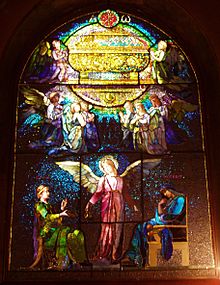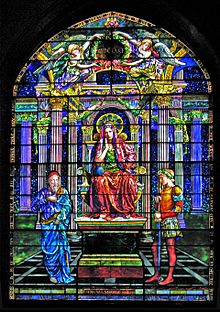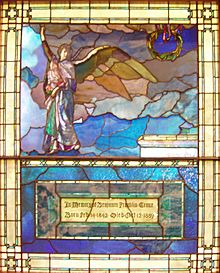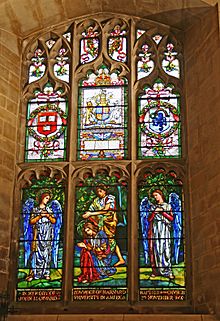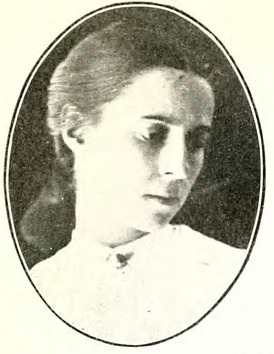John La Farge facts for kids
Quick facts for kids
John La Farge
|
|
|---|---|
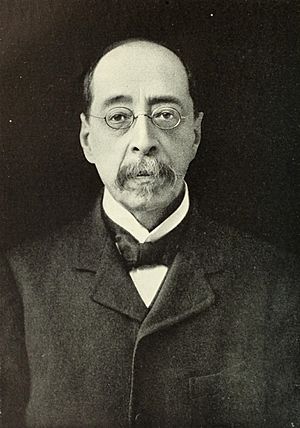
John LaFarge, 1902
|
|
| Born | March 31, 1835 |
| Died | November 14, 1910 (aged 75) |
| Nationality | American |
| Alma mater | Mount St. Mary's University Fordham University |
| Occupation | Painter, stained glass artist, decorator, writer |
| Spouse(s) |
Margaret Mason Perry
(m. 1860) |
| Children | 8, including Christopher, John |
| Signature | |
 |
|
John La Farge (March 31, 1835 – November 14, 1910) was an important American artist. He worked in many different art forms, including illustrations, large wall paintings called murals, interior design, and painting. He also wrote popular books about his travels in Asia and other art topics.
La Farge is most famous for his beautiful stained glass windows. He created many of these, especially for churches on the East Coast of America. His work on stained glass began in 1878 with a big project for Trinity Church in Boston. He continued making stained glass for thirty years. La Farge was not only an artist but also an expert in color. He was also an inventor, getting a special permission (called a patent) in 1880 for a new way to layer glass panes. This invention was important in his disagreements with another famous artist, Louis Comfort Tiffany.
In 1858, La Farge rented a studio space in the Tenth Street Studio Building in Greenwich Village, New York City. He became a well-known artist in the area. He was chosen to join the National Academy of Design in 1863. Later, in 1877, he helped start the Society of American Artists. This group was formed because they felt the National Academy was too old-fashioned. In 1892, La Farge taught at the Metropolitan Museum of Art Schools, helping students learn art skills. He also led the National Society of Mural Painters from 1899 to 1904. In 1904, he was one of the first seven artists asked to join the American Academy of Arts and Letters, a group that honors great American artists and writers.
Contents
Early Life and Art Beginnings
John La Farge was born in New York City. His parents were wealthy French immigrants, and he grew up speaking both French and English. As a child, he and his brothers even made their own magazine in French!
His interest in art started when he was studying at Mount St. Mary's University in Maryland and Fordham University in New York. He also studied law for a while. In 1856, he visited Paris, France, where he decided to study painting with a teacher named Thomas Couture. There, he met many artists and writers. La Farge's first drawings and landscape paintings showed he was very original, especially in how he used colors.
La Farge came back from Europe in 1857. He continued his law studies but spent as much time as possible with his new artist friends. These friends included William James Stillman and members of the Hudson River School, a group of American landscape painters. After his father passed away in 1858, La Farge no longer felt pressured to study law. He also inherited money, which allowed him to get a studio in the new Tenth Street Studio Building. This building was a special place where artists could work and meet each other. It helped La Farge connect with other artists and grow his career.
John La Farge's Artistic Career
Between 1859 and 1870, La Farge worked on illustrations for books, like Tennyson's Enoch Arden. He also created drawings for children's magazines.
Creating Murals and Large Paintings
In the 1870s, La Farge started painting murals. These large wall paintings became very popular for public buildings and churches. His first mural was painted in Trinity Church, Boston, in 1873. He also decorated the Church of the Ascension and St. Paul's Chapel in New York. For his mural Athens at the Bowdoin College Museum of Art, an African-American woman named Hettie Anderson was the model for the main figure. La Farge also took on private projects for wealthy people.
He continued to create murals throughout his life. When he was 71, he painted four large murals for the Minnesota State Capitol that showed the history of law. Some of his last works were six murals about important lawgivers, starting with Moses, for the Baltimore City Court House.
Travels and Inspirations
La Farge traveled a lot, especially in Asia and the South Pacific. These trips greatly inspired his paintings. In 1886, he visited Japan with his friend Henry Adams. In 1890 and 1891, he explored the South Seas, spending time learning about the cultures of Samoa, Tahiti, and Fiji. While in Hawaii in 1890, he painted beautiful scenes on Oahu and even an active volcano on the Island of Hawaii. He wrote all about these travels in his book Reminiscences of the South Seas.
Artistic Recognition and Awards
La Farge was elected to the National Academy of Design in 1863. He later helped create the Society of American Artists in 1877. He taught at the Metropolitan Museum of Art Schools starting in 1892. He was also the president of the National Society of Mural Painters from 1899 to 1904. In 1904, he became one of the first seven artists chosen for the American Academy of Arts and Letters. The French government also honored him with the Cross of the Legion of Honor.
Innovations in Stained Glass
In 1875, La Farge began trying new ways to make stained glass. He wanted to solve problems with colors changing or fading over time. At this time, stained glass was not very common in the United States. His early work was very important for its success.
His stained glass windows were as beautiful as those made in the Middle Ages. He also added new techniques, like using opalescent glass. This type of glass has a milky, shimmering look. He also found new ways to layer and join glass pieces, which made his windows look three-dimensional. Opalescent glass had been used for centuries in dishes, but La Farge was the first to make it into flat sheets for stained-glass windows. He had to order custom sheets from a glass maker in Brooklyn.
La Farge applied for a patent (a legal right to an invention) on November 10, 1879. He received patent number 224,831 on February 24, 1880, for a "Colored-Glass Window." This patent included technical details about how to make opalescent sheet glass and how to layer it for windows.
Famous Stained Glass Works
Some of La Farge's many stained-glass works can be found at:
- Trinity Church, Boston (1877–78)
- Biltmore Estate in Asheville, North Carolina (1881)
- Samuel J. Tilden House, NYC (1881; now the National Arts Club)
- Thomas Crane Public Library, Quincy, Massachusetts (around 1882)
- Unity Church of North Easton, Massachusetts (1882)
- Church of St. Joseph of Arimathea in Greenburgh, New York (1883)
- Blessed Sacrament Church, Providence, Rhode Island
- Christ Church in Lincoln, Rhode Island (1884)
- Trinity Episcopal Church in Buffalo, New York (1886–89)
- St. Paul's Chapel, Columbia University, NYC (1888–99)
- All Saints Episcopal Church, Briarcliff Manor, New York (1889)
- All Souls Unitarian Church, Roxbury, Massachusetts
- First Unitarian Church of Detroit (1890)
- St. Mary's-in-Tuxedo Episcopal Church, Tuxedo Park, New York (1890)
- The Cathedral of All Saints, Albany, New York (around 1890)
- Judson Memorial Church, NYC (1890–93)
- First Unitarian Church of Philadelphia (1891)
- Caldwell Sisters' chapel, Newport, Rhode Island (now at Salve Regina University) (1891)
- Mount Vernon Church, Boston (around 1893)
- Church of the Transfiguration, Episcopal, New York City (1898)
- John Harvard Window, Southwark Cathedral, London, England (1907)
Several of his windows, including Peonies Blown in the Wind (1880), are kept at the Metropolitan Museum of Art in New York.
Disagreement with Louis Comfort Tiffany
La Farge seems to have shown Louis Comfort Tiffany how to use opalescent glass in the mid-1870s. However, their relationship became difficult later, likely because of a legal disagreement.
Eight months after La Farge got his patent, Tiffany applied for a similar one, which was granted in 1881. The main difference was that Tiffany's patent focused more on how the glass was used in building. It seemed that neither artist could make stained-glass windows without the other's permission. It's unclear if they ever reached a full agreement. Around 1882, La Farge planned to sue Tiffany, saying Tiffany had copied some of his methods. No official record of a lawsuit has been found, suggesting it might not have been filed. Perhaps as stained glass became more popular, both artists decided it was too much trouble to defend their patents legally.
John La Farge's Family Life
On October 15, 1860, John La Farge married Margaret Mason Perry (1839–1925) in Newport, Rhode Island. Margaret was the granddaughter of Commodore Oliver Hazard Perry, a famous naval hero. Her family also included important colonial leaders like Governor Thomas Prence and Elder William Brewster, who sailed on the Mayflower.
John and Margaret had eight children:
- Christopher Grant La Farge (1862–1938), who became an architect. He designed famous buildings like the original Cathedral of St. John the Divine and parts of the Bronx Zoo.
- Emily Marie La Farge (1862–1890)
- John Louis Bancel La Farge (1865–1938)
- Margaret Angela La Farge (1867–1956)
- Oliver Hazard Perry La Farge (1869–1936), who also became an architect and real estate developer.
- Joseph Raymond La Farge (1872–1872), who died as a baby.
- Frances Aimee La Farge (1874–1951)
- John La Farge, Jr., S.J. (1880–1963), who became a Jesuit priest and worked hard to fight against racism.
John La Farge passed away in 1910 in Providence, Rhode Island. He was buried at Green-Wood Cemetery in Brooklyn, New York.
Through his eldest son Christopher, John La Farge was the grandfather of Christopher La Farge, a novelist, and Oliver La Farge, a well-known writer and expert on human cultures (anthropologist). Oliver's son, Peter La Farge, was a famous songwriter in the 1960s. He wrote "The Ballad of Ira Hayes," which was made popular by Johnny Cash.
Through his daughter Frances, he was the grandfather of Frances Sergeant Childs. She was a history professor and one of the first teachers at Brooklyn College.
John La Farge's Writings
La Farge also wrote several books and articles about art and his travels. Some of his writings include:
- The American Art of Glass (a small book)
- Considerations on Painting (New York, 1895)
- An Artist's Letters from Japan (New York, 1897)
- The Great Masters (New York)
- Hokusai: a talk about Japanese painting (New York, 1897)
- The Higher Life in Art (New York, 1908)
- One Hundred Great Masterpieces
- Reminiscences of the South Seas (1912)
- The Gospel Story in Art (New York, 1913)
His personal papers and some of his children's and grandchildren's papers are kept at Yale University Library.
Images for kids
-
Portrait of the Novelist Henry James, 1862
-
Kilauea, Looking at Cone of Crater, 1890, Honolulu Museum of Art
-
Diadem Mountain at Sunset, Tahiti - Brooklyn Museum
See also
 In Spanish: John LaFarge para niños
In Spanish: John LaFarge para niños



